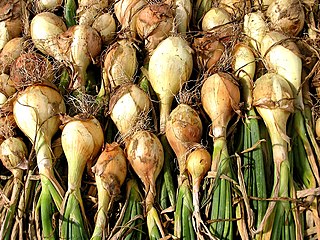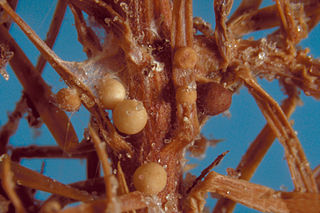
Armillaria is a genus of fungi that includes the A. mellea species known as honey fungi that live on trees and woody shrubs. It includes about 10 species formerly categorized summarily as A. mellea. Armillarias are long-lived and form the largest living fungi in the world. The largest known organism covers more than 3.4 square miles (8.8 km2) in Oregon's Malheur National Forest and is estimated to be 2,500 years old. Some species of Armillaria display bioluminescence, resulting in foxfire.

Botrytis cinerea is a necrotrophic fungus that affects many plant species, although its most notable hosts may be wine grapes. In viticulture, it is commonly known as "botrytis bunch rot"; in horticulture, it is usually called "grey mould" or "gray mold".

Texas root rot is a disease that is fairly common in Mexico and the southwestern United States resulting in sudden wilt and death of affected plants, usually during the warmer months. It is caused by a soil-borne fungus named Phymatotrichopsis omnivora that attacks the roots of susceptible plants. It was first discovered in 1888 by Pammel and later named by Duggar in 1916.

White onion or Allium cepa are a cultivar of dry onion which have a distinct light and mild flavour profile. Much like red onions, they have a high sugar and low sulphur content, and thus have a relatively short shelf life. White onions are used in a variety of dishes, such as those of Mexican and European origin. Their uses in dishes often relate to their mild nature, they are often included in dishes to provide a light, fresh and sour taste to dishes and are often added uncooked to dishes such as salads.

Trichoderma viride is a fungus and a biofungicide.
This is a glossary of some of the terms used in phytopathology.

Rhizoctonia solani is a species of fungus in the order Cantharellales. Basidiocarps are thin, effused, and web-like, but the fungus is more typically encountered in its anamorphic state, as hyphae and sclerotia. The name Rhizoctonia solani is currently applied to a complex of related species that await further research. In its wide sense, Rhizoctonia solani is a facultative plant pathogen with a wide host range and worldwide distribution. It causes various plant diseases such as root rot, damping off, and wire stem. It can also form mycorrhizal associations with orchids.

Helicobasidium purpureum is a species of fungus in the subdivision Pucciniomycotina. Basidiocarps are corticioid (patch-forming) and are typically violet to purple. Microscopically they have auricularioid basidia. Helicobasidium purpureum is an opportunistic plant pathogen and is one of the causes of violet root rot of crops and other plants. DNA sequencing suggests that it is a complex of more than one species. The species has a conidia-bearing anamorph in the Tuberculina persicina complex that is a parasite of rust fungi.
Helicobasidium longisporum is a species of fungus in the subdivision Pucciniomycotina. Basidiocarps are corticioid (patch-forming) and are typically violet to purple. Microscopically they have auricularioid basidia. Helicobasidium longisporum is an opportunistic plant pathogen and is one of the causes of violet root rot of crops and other plants. DNA sequencing suggests that it is a complex of more than one species.

Ceratobasidium cornigerum is a species of fungus in the order Cantharellales. Basidiocarps are thin, spread on the substrate out like a film (effused) and web-like. An anamorphic state is frequently obtained when isolates are cultured. Ceratobasidium cornigerum is saprotrophic, but is also a facultative plant pathogen, causing a number of economically important crop diseases, and an orchid endomycorrhizal associate. The species is genetically diverse and is sometimes treated as a complex of closely related taxa. DNA research shows the species actually belongs within the genus Rhizoctonia.
Magnaporthe salvinii is a fungus known to attack a variety of grass and rice species, including Oryza sativa and Zizania aquatica. Symptoms of fungal infection in plants include small, black, lesions on the leaves that develop into more widespread leaf rot, which then spreads to the stem and causes breakage. As part of its life cycle, the fungus produces sclerotia that persist in dead plant tissue and the soil. Management of the fungus may be effected by tilling the soil, reducing its nitrogen content, or by open field burning, all of which reduce the number of sclerotia, or by the application of a fungicide.
Helicobasidium mompa is a species of fungus in the subdivision Pucciniomycotina. Basidiocarps are corticioid (patch-forming) and are typically violet to purple. Microscopically they have auricularioid basidia. Helicobasidium mompa is an opportunistic plant pathogen and is one of the causes of violet root rot of crops and other plants. DNA sequencing suggests that it is a distinct, eastern Asian species.

Armillaria novae-zelandiae is a species of mushroom-forming fungus in the family Physalacriaceae. This plant pathogen species is one of three Armillaria species that have been identified in New Zealand.

Ceratobasidium is a genus of fungi in the order Cantharellales. Basidiocarps are effused and the genus is sometimes grouped among the corticioid fungi, though species also retain features of the heterobasidiomycetes. Anamorphic forms were formerly referred to the genus Ceratorhiza, but this is now considered a synonym of Rhizoctonia. Ceratobasidium species, excluding the type, are also now considered synonymous with Rhizoctonia and some species have been transferred to the latter genus. Species are saprotrophic, but several are also facultative plant pathogens, causing a number of commercially important crop diseases. Some are also endomycorrhizal associates of orchids.

Rhizoctonia is a genus of fungi in the order Cantharellales. Species form thin, effused, corticioid basidiocarps, but are most frequently found in their sterile, anamorphic state. Rhizoctonia species are saprotrophic, but some are also facultative plant pathogens, causing commercially important crop diseases. Some are also endomycorrhizal associates of orchids. The genus name was formerly used to accommodate many superficially similar, but unrelated fungi.

Tuberculina is a genus of fungi in the order Helicobasidiales. The genus is a synonym of Helicobasidium, but currently species have not yet been assigned to the latter genus. Tuberculina species are conidia-bearing parasites of rust fungi, forming felt-like, purple patches on their hosts.
Stromatinia cepivora is a fungus in the division Ascomycota. It is the teleomorph of Sclerotium cepivorum, the cause of white rot in onions, garlic, and leeks. The infective sclerotia remain viable in the soil for many years and are stimulated to germinate by the presence of a susceptible crop.

The Platygloeales are an order of fungi in the class Pucciniomycetes. Species in the order have auricularioid basidia and are typically plant parasites on mosses, ferns, and angiosperms, though Platygloea species appear to be saprotrophic.
Naohidea sebacea is a species of fungus in the order Naohideales. The order is currently monotypic, having only one family, one genus, and one species. Basidiocarps of Naohidea sebacea form small, gelatinous pustules on wood-inhabiting species of Botryosphaeriaceae. Microscopically, they produce long, slender, auricularioid basidia and amygdaliform (almond-shaped) basidiospores.

Agroathelia rolfsii is a corticioid fungus in the order Amylocorticiales. It is a facultative plant pathogen and is the causal agent of "southern blight" disease in crops.














